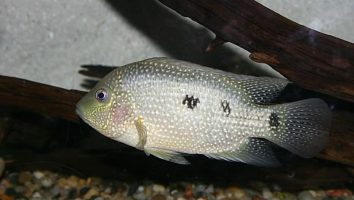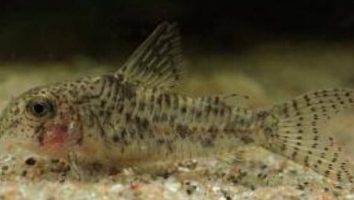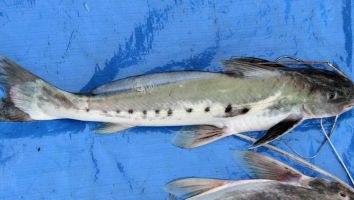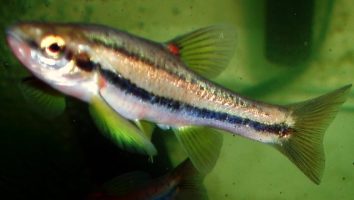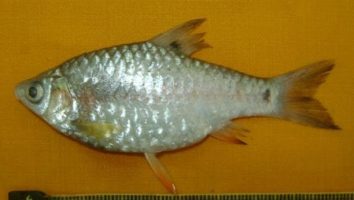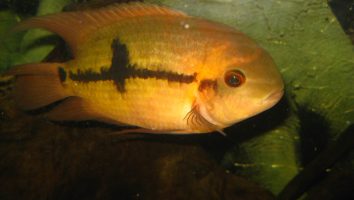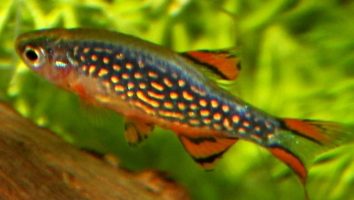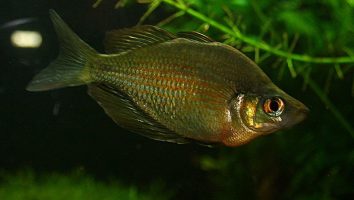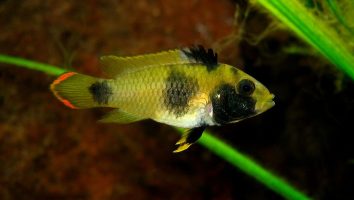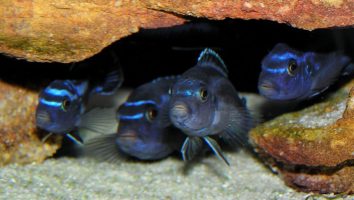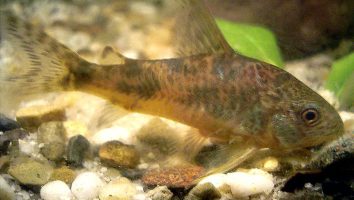The longnose gar is a freshwater fish that is native to North America.
They are a popular fish in the aquarium trade, and their popularity is well deserved. They are a beautiful fish that is relatively easy to care for.
However, there are a few things that you need to know before you get one. In this Fish Academia guide, we will go over everything that you need to know about longnose gar care.
Table of contents
Species overview
The longnose gar (scientific name: Atractosteus spatula) is a fish that’s native to freshwaters all throughout North and Central America.
They prefer areas with little to no vegetation and a lot of open space to swim. This is something to keep in mind when setting up their tank because you’ll want to make sure there’s plenty of room for them to move around.
Longnose gars are some of the largest freshwater fish in North America and can grow to be over six feet long! They are a popular choice for fishing because of their size and the fact that they put up quite a fight when hooked.
They are also a popular choice for aquariums, although they can be difficult to care for. This is mostly due to their size, but as long as you have the space and resources to care for them properly they can make for an impressive addition to any freshwater setup.
Appearance
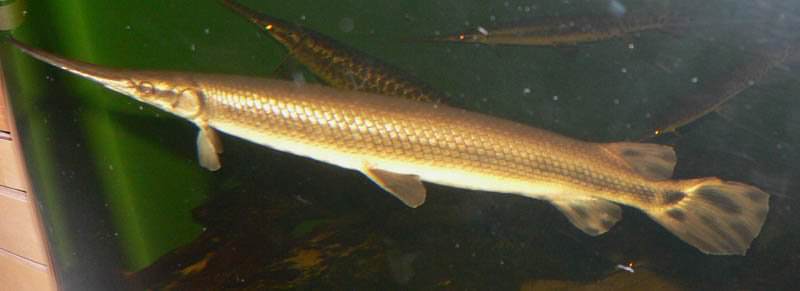
The Longnose Gar is an intimidating fish that’s sure to turn heads when people see it. It has a long, thin body that can grow up to 6 feet in length!
The coloration on this fish is quite unique. The base color is a dark olive green that has a bit of a metallic sheen to it. There are also a series of dark spots that run along the length of the body. These spots are elongated and have a bit of a jagged appearance.
The fins on the Longnose Gar are also quite unique. The dorsal fin is located about halfway back on the body and extends the entire length of the fish. The anal fin is much shorter and located closer to the tail.
The pectoral fins are located on the side of the fish and are used for steering. The caudal fin is forked and helps the fish move through the water.
The Longnose Gar has a long, thin snout that gives it its name. This snout is lined with sharp teeth that are used to capture prey.
The eyes of the Longnose Gar are located on the top of the head. This allows them to see prey both above and below them.
Lifespan
The lifespan of a Longnose Gar in captivity is typically between 10 and 20 years. These fish have been known to live even longer in captivity though, with some reports of individuals reaching 30 years of age or more.
As is the case with most fish, the quality of care they receive will have a big impact on how long they live. If they’re kept in poor conditions, their lifespan will be significantly shorter.
Size
The average size of a Longnose Gar is between 4 and 5 feet long, but they can grow to be up to 7 feet long. These fish can also weigh up to 30 pounds when they are fully grown.
Tank
Tank Size
The recommended minimum tank size for longnose gar is 180 gallons. If you’re looking for a freshwater fish that can fit in an average-sized tank, this is not the fish for you.
Longnose gar are very active fish and need a lot of space to swim. They are also very sensitive to water quality and need very clean water to thrive.
Water Parameters
The longnose gar is a freshwater fish that’s native to North America. It’s a popular choice for aquariums because of its unique appearance and peaceful demeanor.
Despite its popularity, the longnose gar is not a beginner-friendly fish. They’re very sensitive to poor water conditions and require a well-maintained aquarium.
If you’re up for the challenge, here are a few water parameters to keep in mind.
- Water temperature: 70 to 80 degrees Fahrenheit
- pH levels: 6.8 to 7.8
- Water hardness: 5 to 20 dGH
- Alkalinity Levels: 3-10 dKH
What To Put In Their Tank
When it comes to setting up the inside of an aquarium for a Longnose Gar you have a few different options.
The first (and most important) thing you need to include is a lot of open swimming space. These fish are constantly on the move and need room to roam.
The second thing you need to consider is the type of substrate you use. We recommend a sand substrate for two reasons. First, it’s softer on their bellies which can get scratched up easily. Second, it provides a better buffer against potential injuries.
Rocks and driftwood are fine to add as well, but use them sparingly. Too much and you’ll decrease the amount of open space in the tank which is the last thing you want.
Plants are a bit of a touchy subject with Longnose Gars. They’re known to nibble on vegetation, but some aquarists have had success keeping live plants in their tanks. If you decide to go this route we recommend fast-growing plants that can handle a little abuse (Hornwort, Water Wisteria, or Java Moss are all good choices).
Common Diseases
Longnose Gar are actually pretty hardy fish. They don’t fall ill often and are rather resistant to disease.
However, that doesn’t mean that they can’t get sick. In fact, the most common ailment that these fish experience is actually hole-in-the-head disease.
This disease is caused by a number of things, but the most common culprit is poor water quality. It can also be brought on by the presence of activated carbon in your tank.
This disease will present itself as one or two pits/holes in the skin of your Longnose Gar’s head. While it’s almost always curable (fixing your water quality and removing activated carbon is usually all you need to do), it will usually leave some scarring on your poor fish!
The other disease you might see in your Longnose Gar is ich. This is a very common freshwater disease that can affect any fish, no matter the species.
This will show itself as white spots on the body, fish, and gills of your fish. We won’t do a full ich treatment guide here (there are plenty of those online) but it’s something you need to take very seriously if it affects your Longnose Gar.
Behavior & Temperament
The longnose gar is a predatory fish, so it’s important to be aware of that before adding one to your tank. It’s not necessarily aggressive, but it will eat smaller fish if given the chance. So, it’s best to keep them with larger fish.
These fish are also known to be jumpers, so you’ll need to make sure your tank is covered. They can launch themselves out of the water and onto the floor, which can hurt them.
Other than that, the longnose gar is a relatively peaceful fish. It’s not going to bother other fish unless it’s hungry. And, even then, it’s more likely to eat smaller fish that are swimming near the bottom of the tank.
The longnose gar is a curious fish, so it’s fun to watch. It will often swim near the surface of the water to check things out. And, it’s not uncommon to see them “playing” with other fish in the tank.
Tank Mates
When it comes to finding tank mates for Longnose Gar, the options are unfortunately quite limited. These fish are large, aggressive, and have a voracious appetite.
They’re also fast and can easily outmaneuver most other fish in the tank.
The good news is that the fish is peaceful towards its own kind. You can safely keep multiple Longnose Gar together in the same aquarium.
As for other tank mates, the only real option is other large, aggressive fish. These fish need to be able to hold their own against the Longnose Gar.
Some suitable tank mates include:
- Alligator Gar
- Arowana
- Pacu
- Piranha
- Tiger Shovelnose Catfish
- Wels Catfish
- Arapaima
Breeding
Longnose Gar are one of the easier fish to breed in captivity. They’re not too picky about their environment and will readily spawn in most aquariums.
The first step is to set up a suitable breeding tank. It should be at least 100 gallons and have a sandy bottom. You’ll also need to add some plants and hiding places.
Once the tank is set up, you’ll need to sex your fish. This can be tricky since they don’t have too many physical differences. The best way to tell is by their size. Males grow to be about 3 feet long while females only get to be about 2 feet.
Once you’ve determined the sexes of your fish, it’s time to add the female. She should be added a few days before the male to give her time to acclimate.
When ready, add the male to the tank. He will usually start to court the female within a few hours. The spawning process itself is pretty quick.
After the eggs have been laid, the male will guard them. He will fan them with his fins to keep them oxygenated and free of debris.
The eggs will hatch in about a week. You can start feeding the fry live foods like brine shrimp and bloodworms. As they grow, you can transition them to pellets and flakes.
Conclusion
The Longnose Gar is a great fish for the beginner to intermediate fish keeper. They are relatively easy to care for and can be a great addition to your freshwater aquarium.
With their unique appearance and peaceful nature, they are sure to be a hit with everyone in the family.
Just be sure to do your research before bringing one home, as they do require a bit of a larger tank than most fish.
Other than that, we think you’ll be very happy with your Longnose Gar!

